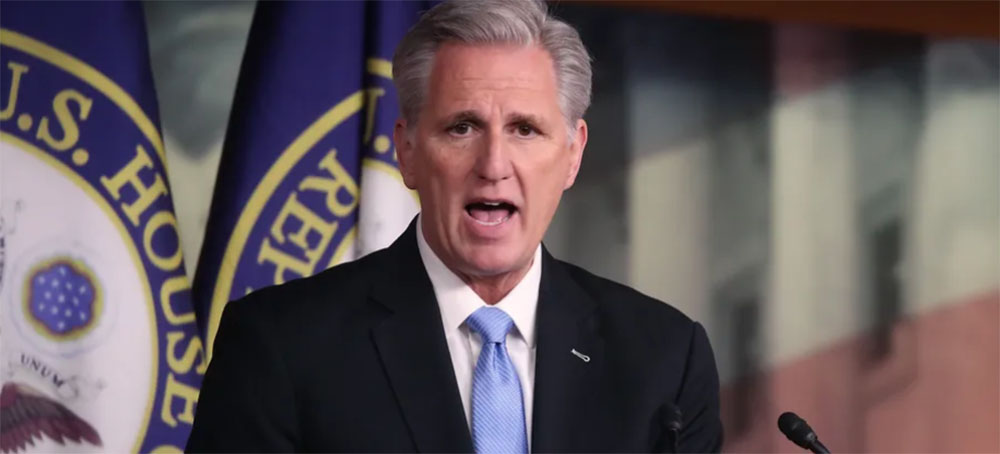The Republican Revolt Over the Debt Limit Deal
Li Zhou Vox House Minority Leader Kevin McCarthy (R-CA) speaks during his weekly news conference at the US Capitol on February 27, 2020, in Washington, DC. (photo: Mark Wilson/Vox)
House Minority Leader Kevin McCarthy (R-CA) speaks during his weekly news conference at the US Capitol on February 27, 2020, in Washington, DC. (photo: Mark Wilson/Vox)
There’s a deal to avoid a catastrophic default on the US debt. But will House Republicans go for it?
This past weekend, McCarthy and President Joe Biden announced a deal to suspend the debt ceiling until 2025, and cap nondefense spending for two years. The agreement also expands the age range of those required to work to receive food stamps, and would restart student loan payments at the end of this summer, which have been suspended since March 2020. This compromise has very swiftly gotten blowback from conservative Republicans, who wanted deeper cuts to social spending, and progressive Democrats, who raised concerns about changes to work requirements.
“We should kill this,” Rep. Chip Roy (R-TX), a vocal opponent of the agreement said in a Fox News appearance on Monday, noting that Republicans didn’t get enough in exchange for suspending the debt ceiling.
The scramble to pass the legislation in Congress comes as lawmakers stare down a rapidly approaching default deadline on Monday, June 5, when the country may be unable to pay all of its bills.
A simple majority of 218 votes will be needed to pass debt ceiling legislation in the House. Because House Republicans have such a narrow 222-person majority — Democrats control 213 seats — they’ll likely need Democrats’ help to get this bill across the finish line. Members from both parties are expected to defect, so Republicans are unlikely to be able to pass this on their own despite having House control.
Looming over the vote is also an unspoken threat against McCarthy’s leadership, which, according to House rules, can be challenged if just one member wants to do so. A majority of the House, however, would have to vote to remove him as Speaker, and it’s unclear whether there are enough votes from either party to achieve that.
The Wednesday vote, as well as another key procedural hurdle the bill needs to clear, will be indicative of how strong McCarthy’s relationships are with the different flanks of the GOP. “Over 95 percent were overwhelmingly excited about what they see,” McCarthy claimed in a Fox News Sunday appearance about his members’ reaction to the bill.
Why Republicans are fighting about the bill
House Republicans’ central disagreement is whether the cuts that McCarthy got out of negotiations were substantial enough to trade for suspending the debt ceiling. The agreement wound up capping nondefense spending for fiscal year 2024 and would allow a 1 percent spending increase for fiscal year 2025. In House Republicans’ debt ceiling bill — known as the Limit, Save and Grow Act — spending caps would have been put in place through 2033. Additionally, House Republicans’ bill had more aggressive work requirements for SNAP and Medicaid.
“The concessions made by the Speaker in his negotiations with President Biden fall far short of my expectations,” Rep. Wesley Hunt (R-TX), a Republican who opposes the deal, wrote on Twitter. Members of the conservative House Freedom Caucus are among those who are expected to line up against the agreement.
Ahead of a final vote on Wednesday, a Rules Committee meeting on Tuesday afternoon could also foreshadow how dramatic Republican in-fighting over the debt ceiling might get, and how much conservatives want to go up against McCarthy to make a point. The Rules panel, which includes nine Republicans and four Democrats, will have to vote to approve the bill before it heads to the floor for a vote.
Roy, as well as Rep. Ralph Norman (R-SC), another Rules Committee member, have said they oppose the legislation, but it’s uncertain whether other Republicans on the panel will do the same. Rep. Thomas Massie (R-KY), in particular, is expected to be a key swing vote. Roy has suggested that McCarthy previously agreed that a measure would need the support of all nine Republicans in the Rules Committee to proceed to a vote, a claim the Speaker’s allies have questioned.
Theoretically, if seven Republicans, or a combination of Republicans and Democrats on the Rules Committee, supported the debt ceiling legislation, it would still have the number of votes typically needed to advance to the floor. The outcome of the Committee vote could signal how aggressive Republican opposition is to the bill.
Following the Committee vote, the debt ceiling legislation will need a simple majority to clear the House and 60 votes in the Senate in order to clear the filibuster threshold.



